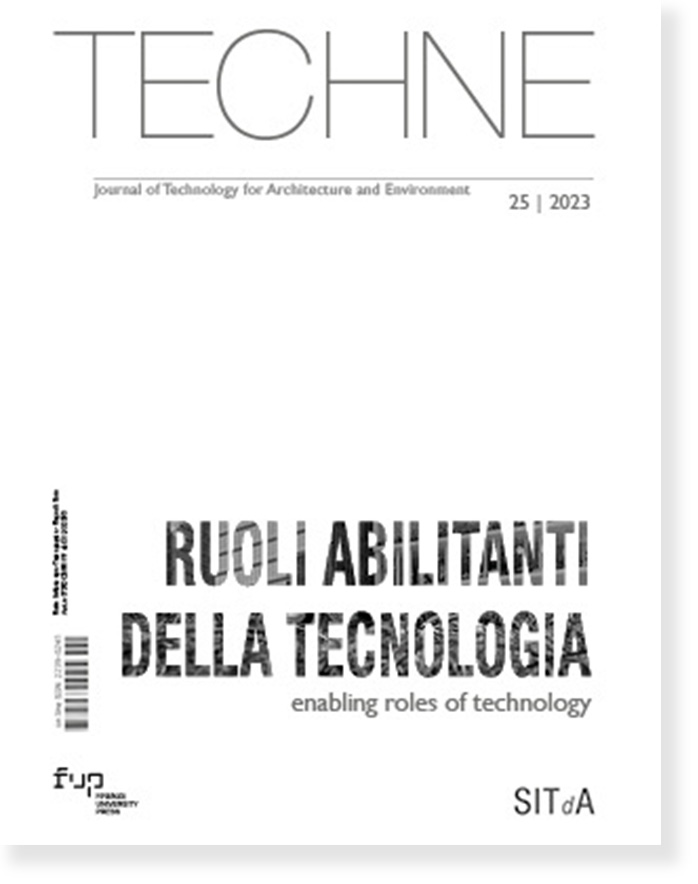Published 2023-05-30
Keywords
- Interfaces,
- Responsive architecture,
- Computational design,
- Design by data
How to Cite
Copyright (c) 2023 Attilio Nebuloni, Giorgio Buratti

This work is licensed under a Creative Commons Attribution 4.0 International License.
Abstract
Since the rise of the digital revolution in architecture, and even more so with the emergence of a new generation of enabling technologies structured on digital interfaces, the interactive-relational dimension has become central to the design agenda. The experimentation on responsive morphologies that emerge from the synergy between data and design, and whose artefacts mark a return to the real world that incorporates physicality into the design process is significant. In addition, they represent a synthesis of the ability of such digital technologies to dynamically discriminate, process, and interpret heterogeneous potential data derived from the context.
Downloads
References
Buratti, G. (2017). “Il disegno computazionale. La forma come organizzazione”, in Nebuloni, A. e Rossi, A. (a cura di), Codice e Progetto. Il computational design tra architettura, design, territorio, rappresentazione, strumenti, materiali e nuove tecnologie. Mimesis Edizioni, Milano.
Cabitza, F. (2021). “Deus in machina? L’uso umano delle nuove macchine, tra dipendenza e responsabilità”, in Floridi, L., Cabitza, F. (a cura di), Intelligenza Artificiale. L’uso delle nuove macchine, Bompiani, Milano.
Carpo, M. (2017a). “Building with geometry, drawing with numbers”, in Goodhouse, A. (ed. by), When is the digital in architecture?, Sternberg, Berlin.
Carpo, M. (2017b). The second digital turn. Design Beyond Intelligence, the MIT Press.
Corbellini, G. (2013). “Ultimo tango a Zagarol”, in Corbellini, G. e Morassi, C. (a cura di), Parametrico nostrano, Lettera ventidue, Siracusa.
Floridi, L. (2017). La quarta rivoluzione. Come l’infosfera sta trasformando il mondo, Raffaello Cortina Editore, Milano.
Floridi, L. (2021). “Agere sine Intelligere. L’intelligenza artificiale come nuova forma di agire e i suoi problemi etici”, in Floridi, L. e Cabitza, F. (a cura di), Intelligenza Artificiale. L’uso delle nuove macchine, Bompiani, Milano.
Frazer, J. (1995). An Evolutionary Architecture. London, AA Press.
Nebuloni, A. e Vignati, G. (2020). “Design data-driven e movimento. Un approccio metodologico alla progettazione”, in Perriccioli, M., Rigillo, M., Russo Ermolli, S., Tucci, F. (a cura di), Design in the Digital Age. Technology, Nature, Culture, Maggioli Editore, Santarcangelo di Romagna (RN).
Rossi, A. (2017). “Architettura come interfaccia”, in Nebuloni, A. e Rossi, A. (a cura di), Codice e Progetto. Il computational design tra architettura, design, territorio, rappresentazione, strumenti, materiali e nuove tecnologie. Mimesis Edizioni, Milano.
Speed, C. & Oberlander, J. (2016). “Designing from, with and by Data: Introducing the ablative framework”, in Lloyd, P., Bohemia, E. (ed by.), Proceedings of DRS2016, Brighton.






